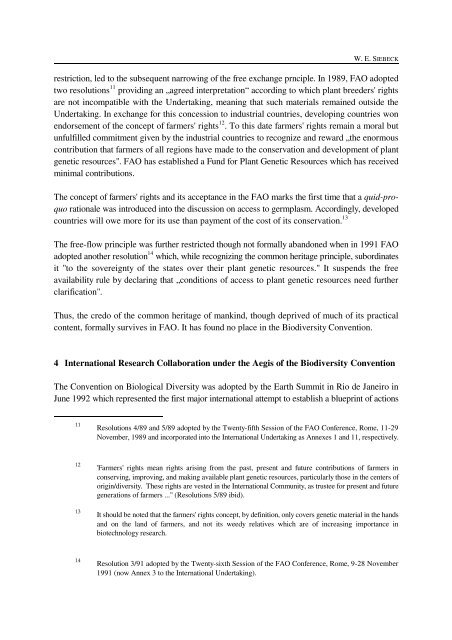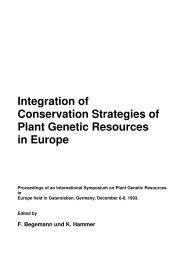Zugang zu Pflanzengenetischen Ressourcen für die ... - Genres
Zugang zu Pflanzengenetischen Ressourcen für die ... - Genres
Zugang zu Pflanzengenetischen Ressourcen für die ... - Genres
Sie wollen auch ein ePaper? Erhöhen Sie die Reichweite Ihrer Titel.
YUMPU macht aus Druck-PDFs automatisch weboptimierte ePaper, die Google liebt.
W. E. SIEBECK<br />
restriction, led to the subsequent narrowing of the free exchange prnciple. In 1989, FAO adopted<br />
two resolutions 11 providing an „agreed interpretation“ according to which plant breeders' rights<br />
are not incompatible with the Undertaking, meaning that such materials remained outside the<br />
Undertaking. In exchange for this concession to industrial countries, developing countries won<br />
endorsement of the concept of farmers' rights 12 . To this date farmers' rights remain a moral but<br />
unfulfilled commitment given by the industrial countries to recognize and reward „the enormous<br />
contribution that farmers of all regions have made to the conservation and development of plant<br />
genetic resources". FAO has established a Fund for Plant Genetic Resources which has received<br />
minimal contributions.<br />
The concept of farmers' rights and its acceptance in the FAO marks the first time that a quid-proquo<br />
rationale was introduced into the discussion on access to germplasm. Accordingly, developed<br />
countries will owe more for its use than payment of the cost of its conservation. 13<br />
The free-flow principle was further restricted though not formally abandoned when in 1991 FAO<br />
adopted another resolution 14 which, while recognizing the common heritage principle, subordinates<br />
it "to the sovereignty of the states over their plant genetic resources." It suspends the free<br />
availability rule by declaring that „conditions of access to plant genetic resources need further<br />
clarification".<br />
Thus, the credo of the common heritage of mankind, though deprived of much of its practical<br />
content, formally survives in FAO. It has found no place in the Biodiversity Convention.<br />
4 International Research Collaboration under the Aegis of the Biodiversity Convention<br />
The Convention on Biological Diversity was adopted by the Earth Summit in Rio de Janeiro in<br />
June 1992 which represented the first major international attempt to establish a blueprint of actions<br />
11<br />
12<br />
13<br />
14<br />
Resolutions 4/89 and 5/89 adopted by the Twenty-fifth Session of the FAO Conference, Rome, 11-29<br />
November, 1989 and incorporated into the International Undertaking as Annexes 1 and 11, respectively.<br />
'Farmers' rights mean rights arising from the past, present and future contributions of farmers in<br />
conserving, improving, and making available plant genetic resources, particularly those in the centers of<br />
origin/diversity. These rights are vested in the International Community, as trustee for present and future<br />
generations of farmers ..." (Resolutions 5/89 ibid).<br />
It should be noted that the farmers' rights concept, by definition, only covers genetic material in the hands<br />
and on the land of farmers, and not its weedy relatives which are of increasing importance in<br />
biotechnology research.<br />
Resolution 3/91 adopted by the Twenty-sixth Session of the FAO Conference, Rome, 9-28 November<br />
1991 (now Annex 3 to the International Undertaking).










